These Sample papers are part of CBSE Sample Papers for Class 12 Biology. Here we have given CBSE Sample Papers for Class 12 Biology Paper 3.
CBSE Sample Papers for Class 12 Biology Paper 3
| Board | CBSE |
| Class | XII |
| Subject | Biology |
| Sample Paper Set | Paper 3 |
| Category | CBSE Sample Papers |
Students who are going to appear for CBSE Class 12 Examinations are advised to practice the CBSE sample papers given here which is designed as per the latest Syllabus and marking scheme as prescribed by the CBSE is given here. Paper 3 of Solved CBSE Sample Paper for Class 12 Biology is given below with free PDF download solutions.
Time Allowed: 3 hours
Maximum Marks: 80
General Instructions:
- There are total 26 questions and five sections in the question paper. All questions are compulsory.
- Section A contains question number 1 to 5, Very Short Answer Type Questions of one mark each.
- Section B contains question number 6 to 10, Short Answer Type Questions of two marks each.
- Section C contains question number 11 to 22, Short Answer Type Questions of three marks each.
- Section D contains question number 23, Value Based Question of four mark.
- Section E contains question number 24 to 26, Long Answer Type Questions of five marks each.
- There is no overall choice in the question paper, however, an internal choice is provided in one question of two marks, one question of three marks and all three questions of five marks. An examiner is to attempt any one of the question out of the two given in the question paper with the same question number.
- No. of printed pages are three.
SECTION-A
Question 1.
Identify the types of immunization in case of injection of ready made antibodies for a tetanus case.
Question 2.
What are Homologous organs?
Question 3.
What is the sequence of nitrogen bases of the coding strand of DNA in a transcription unit?
Question 4.
Explain the term emasculation.
Question 5.
What is Adaptive radiation?
SECTION-B
Question 6.
How do sweet potato and potato differ in terms of evolution?
Question 7.
Identify the diagram and label the parts.
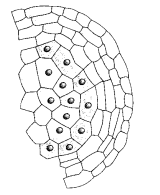
Question 8.
What are the barriers that comprise innate immunity?
Question 9.
What are the parts of the fallopian tube?
Question 10.
What is out-crossing?
OR
What is succession?
SECTION-C
Question 11.
What is the principle of Genetic equilibrium?
Question 12.
Draw a labelled diagram of a human sperm
Question 13.
List the salient features of DNA double helix model.
OR
Explain the parts of an ovule with a diagram
Question 14.
Explain convergent evolution with examples
Question 15.
What do you mean by withdrawal syndrome? Write the side effects of the use of anabolic steroids in males.
Question 16.
Explain some methods of Molecular Diagnosis.
Question 17.
Explain with examples, how do the plant-animal interactions involve co-evolution.
Question 18.
Cancer is one of the most dreaded diseases of human beings and is a major cause of death all over the globe. Explain the
(1) Causes of cancer
(2) Techniques of detection and diagnosis
(3) Treatment and cure
Question 19.
The rate of decomposition of detritus is affected by the abiotic factors like availability of oxygen, pH of the soil substratum, temperature etc. Discuss.
Question 20.
What are the different methods of breeding?
Question 21.
When is insulin fully functional?
Question 22.
You have identified a useful gene in a bacteria. Make a flow chart of the steps that you would follow to transfer this gene to a plant.
SECTION-D
Question 23.
A young couple quarrelled with the hospital authority on suspicion that their child had been exchanged after birth. The couple based their argument on the fact that their child is O blood group whereas they are A and B blood groups respectively. The doctor smiled and explained.
(a) What values of the doctor is reflected here?
(b) How can the child be O blood group as explained by the doctor?
(c) Which test method can be considered authentic to identify the biological parents of the child?
(d) Name the other blood group(s) which the child could have inherited.
SECTION-E
Question 24.
(a) What may be the probable reasons for greater biodiversity of tropics?
(b) Explain the importance of species diversity in reference to the “rivet popper hypothesis”.
OR
Give the journey of sperm formation with diagram. What are the hormones involved
Question 25.
In a medium where E.coli was growing, lactose was added, which induced the lac operon. Then why does the lac operon shut down after some time after the addition of lactose in the medium. Explain.
OR
Answer the following:
(a) Represent schematically the independent assortment of chromosomes.
(b) What are the requisites for a molecule to be a genetic material?
Question 26.
How do you represent the food and energy relationships between organisms?
OR
What are biogeochemical cycles? Explain the carbon cycle.
Answers
SECTION-A
Answer 1.
Passive immunization.
Answer 2.
The same structure developed along different directions due to adaptations to different needs. This is divergent evolution and these structures are homologous. Homology indicates common ancestry.
Answer 3.
5′ – AUGAAUG – 3′
Answer 4.
If the female parent bears bisexual flowers, removal of anthers from the flower bud before the anther dehisces using a pair of forceps is necessary. This step is referred to as emasculation.
Answer 5.
This process of evolution of different species in a given geographical area starting from a point and literally radiating to other areas of geography (habitats) is called adaptive radiation.
SECTION-B
Answer 6.
Sweet potato is a root modification and potato is a stem modification. Different structures evolving for same function are considered analogous structures and are examples of convergent evolution.
Answer 7.
Structure of microsporangium showing wall layers
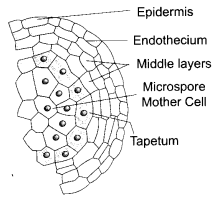
Answer 8.
Innate immunity consists of four types of barriers. These are:
- Physical barriers
- Physiological barriers
- Cellular barriers
- Cytokine barriers
Answer 9.
Infundibulum with fimbriae, Ampulla, Isthmus that joins with the uterus.
Answer 10.
The practice of mating of animals within the same breed, but having no common ancestors on either side of their pedigree up to 4-6 generations. The offspring of such a mating is known as an out-cross.
OR
The gradual and fairly predictable change in the species composition of a given area is called Ecological succession. Example: hydrarch and xerarch succession.
SECTION-C
Answer 11.
Hardy-Weinberg principle states that allele frequencies in a population are stable and is constant from,generation to generation. The gene pool (total genes and their alleles in a population) remains constant. This is called genetic equilibrium. Sum total of all the allelic frequencies is 1. Individual frequencies, for example, can be named/), q, etc. In a diploide P and q represent the frequency of allele A and allele a. The frequency of AA individuals in a population is simply p2 The probability that an allele A with a frequency of p appear on both the chromosomes of a diploid individual is simply the product of the probabilities, i.e.,p2 Similarly of aa is q2, of Aa 2pq. Hence, p2 + 2pq + q2 = 1. This is a binomial expansion of (p + qf. When frequency measured differs from expected values, the difference (direction) indicates the extent of evolutionary change. Disturbance in genetic equilibrium, or Hardy-Weinberg equilibrium, i.e., change of frequency of alleles in a population would then be interpreted as resulting in evolution.
Answer 12.
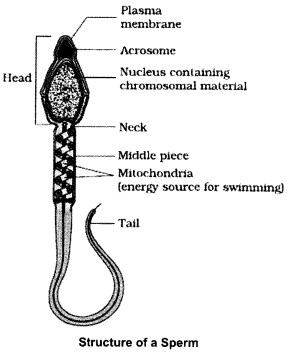
Answer 13.
The salient features of the Double-helix structure of DNA are as follows:
- It is made of two polynucleotide chains, where the backbone is constituted by sugarphosphate, and the bases project inside.
- The two chains have anti-parallel polarity. It means, if one chain has the polarity 5′ – >3′, the other has 3′ – >5′.
- The bases in two strands are paired through hydrogen bond (H-bonds) forming base pairs. Adenine forms two hydrogen bonds with Thymine from opposite strand and vice-versa. Similarly, Guanine is bonded with Cytosine with three H-bonds. As a result, always a purine comes opposite to a pyrimidine. This generates approximately uniform distance between the two strands of the helix.
- The two chains are coiled in a right-handed fashion. The pitch of the helix is 3.4 nm (a nanometre is one billionth of a metre, that is 10-9 m) and there are roughly 10 bp in each turn. Consequently, the distance between a bp in a helix is approximately equal to 0.34 nm.
- The plane of one base pair stacks over the other in double helix. This, in addition to H-bonds, confers stability of the helical structure.
OR
The ovule is a small structure attached to the placenta by means of a stalk called funicle. The body of the ovule fuses with funicle in the region called hilum. Each ovule has one or two protective envelopes called integuments. Integuments encircle the ovule except at the tip where a small opening called the micropyle is organised. Opposite the micropylar end, is the chalaza, representing the basal part of the ovule. Enclosed within the integuments is a mass of cells called the nucellus. Cells of the nucellus have abundant reserve food materials. Located in the nucellus is the embryo sac or female gametophyte.
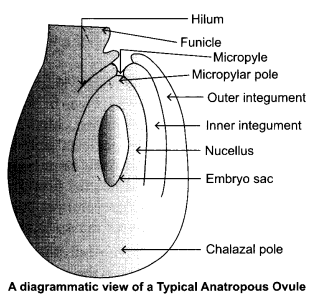
Answer 14.
Convergent evolution: Evolution of different structures for the same function and hence having similarity. The similar habitat that has resulted in selection of similar adaptive features in different groups of organisms but toward the same function. Examples are the eye of the octopus and of mammals, the flippers of Penguins and Dolphins. Sweet potato (root modification) and potato (stem modification). Similarities in proteins and genes performing a given function among diverse organisms give clues to common ancestry.
Answer 15.
The tendency of the body to manifest a characteristic and unpleasant withdrawal syndrome if regular dose of drugs/alcohol is abruptly discontinued. This is characterised by anxiety, shakiness, nausea and sweating, which may be relieved when use is resumed again. In some cases, withdrawal symptoms can be severe.
The side effects of the use of anabolic steroids in males are: Reduction of the size of testicles, decreased sperm production, potential for kidney and liver dysfunction, breast enlargement, premature baldness, enlargement of the prostate gland, and premature closure of the growth centres of the long bones which result in stunted growth, acne, increased aggressiveness, mood swing, depression.
Answer 16.
Some methods of Molecular Diagnosis are:
(1) Recombinant DNA Technology: It includes isolating the antibiotic resistance gene by cutting out a piece of DNA from a plasmid which was responsible for conferring antibiotic resistance.
(2) Polymerase Chain Reaction (PCR): In this a single stranded DNA or RNA is tagged with a radioactive molecule which is allowed to hybridise to its complementary DNA in a clone of cells followed by using autoradiography.
(3) ELISA: It is based on the principle of antigen-antibody interaction. Infection by pathogen can be detected by the presence of antigens (proteins, glycoroteins, etc.) or by detecting the antibodies synthesised against the pathogen
Answer 17.
Plant-animal interactions often involve co-evolution of the mutualists. For example, the evolutions of the flower and its pollinator species are tightly linked with one another.
In many species of fig trees, there is a tight one-to-one relationship with the pollinator species of wasp. It means that a given fig species can be pollinated only by its ‘partner’ wasp species and no other species. The female wasp uses the fruit’not only as on oviposition (egg-laying) site but uses the developing seeds within the fruit for nourishing its larvae. The wasp pollinates the fig inflorescence while searching for suitable egg-laying sites. In return for the favour of pollination, the fig offers the wasp some of its developing seeds, as food for the developing wasp larvae.
Another example, is of the Mediterranean orchid Ophrys which employs ‘sexual deceit’ to get pollination done by a species of bee. One petal of its flower bears an uncanny resemblance to the female of the bee in size, colour and markings. The male bee is attracted to what it perceives as a female, ‘pseducopulates’ with the flower, and during that process is dusted with pollen from the flower. When this same bee ‘pseudocopulates’ with another flower, it transfers pollen to it and thus, pollinates the flower. If the female bee’s colour patterns change even slightly for any reason during evolution, pollination success will be reduced unless the orchid flower co-evolves to maintain the resemblance of its petal to the female bee
Answer 18.
(1) Causes of Cancer:
- Ionizing radiations like X-rays and gamma rays and non-ionizing radiations like UV.
- The chemical carcinogens present in tobacco smoke have been identified as a major cause of lung cancer.
- Oncogenic viruses have genes called viral oncogenes.
(2) Techniques of detection and diagnosis
- Biopsy and histopathological studies of tissues and blood.
- Bone marrow tests for increased cell counts in the case of leukemias.
- Use of antibodies against cancer-specific antigens.
- Techniques of molecular biology is used for detection of genes in individuals with inherited susceptibility to certain cancers.
- Radiography, CT and MRI for cancer of internal organs.
(3) Treatment and Cure:
- Surgery
- Radiation therapy: In radiotherapy, tumor cells are irradiated lethally, taking proper care of the normal tissues surrounding the tumor mass.
- Immunotherapy
- Chemotherapeutic drugs are used to kill cancerous cells. Some of these are specific for particular tumors.
- Use of a-interferons, which activate immune system to destroy tumor.
Answer 19.
Decomposition is largely an oxygen-requiring process. The rate of decomposition is controlled by chemical composition of detritus and climatic factors. In a particular climatic condition, decomposition rate is slower if detritus is rich in lignin and chitin, and quicker, if detritus is rich in nitrogen and water-soluble substances like sugars. Temperature and soil moisture are the most important climatic factors that regulate decomposition through their effects on the activities of soil microbes. Warm and moist environment favour decomposition whereas low temperature inhibits decomposition resulting in build up of organic materials.
Answer 20.
The different methods of breeding are:
- Inbreeding
- Out-breeding
- Out-crossing
- Cross-breeding and
- Interspecific hybridisation
Answer 21.
Insulin is synthesised as a pro-hormone which like a pro-enzyme also needs to be processed before it becomes a fully mature and functional hormone and contains an extra stretch called the C peptide. This C peptide is not present in the mature insulin and is removed during maturation into insulin
Answer 22.
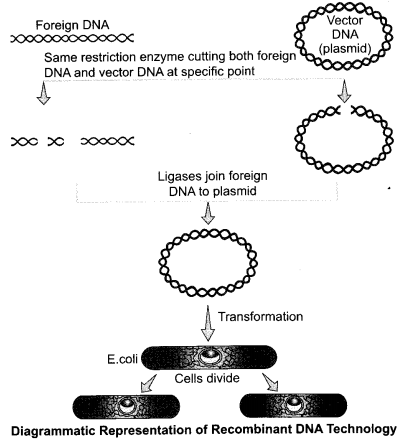
SECTION-D
Answer 23.
(a) The doctor was assertive, patient and pragmatic.
(b) A child can be of blood group O if the parents are heterozygotes, i.e., Ai x Bi. If the child receives i from both the parents, it becomes, ii, and expresses O blood group.
(c) DNA finger printing
(d) A or B or AB.
SECTION-E
Answer 24.
(a) Reasons for the greater biodiversity of tropics.
- Speciation is generally a function of time, unlike temperate regions subjected to frequent glaciations in the past, latitudes have remained relatively undisturbed for millions of years and thus, had a long evolutionary time for species diversification.
- Tropical environments, unlike temperate ones, are less seasonal, relatively more constant and predictable. Such constant environments promote niche specialisation and lead to a greater species diversity.
- There is more solar energy available in the tropics, which contributes to higher productivity; this in turn might contribute indirectly to greater diversity.
(b) The rivet popper hypothesis was used by Paul Ehrlich. It states that in an airplane (ecosystem) all parts are joined together using thousands of rivets (species). If every passenger travelling in it starts popping a rivet to take home (causing a species to become extinct), it may not affect flight safety (proper functioning of the ecosystem) initially, but as more and more rivets are removed, the plane becomes dangcrousl y- weak over a period of time. Furthermore, which rivet is removed may also be critical. Loss of rivets on the wings (key species that drive major ecosystem functions) is obviously a more serious threat to flight safety than loss of a few rivets on the seats or windows inside the plane.
OR
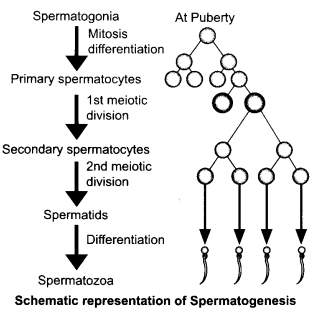
In testis, the immature male germ cells (spermatogonia) produce sperms by spermatogenesis that begins at puberty.
The spermatgonia (sing, spermatogonium) present on the inside wall of seminiferous tubules multiply by mitotic division and increase in numbers. Each spermatogonium is diploid and contains 46 chromosomes. Some of the spermatogonia called primary spermatocytes periodically undergo meiosis.
A primary spermatocyte completes the first meiotic division (reduction division) leading to formation of two equal, haploid cells called secondary spermatocytes, which have only 23 chromosomes each. The secondary spermatocytes undergo the second meiotic division to produce four equal, haploid spermatids. The spermatids are transformed into spermatozoa (sperms) by the process called spermiogenesis. After spermiogenesis, sperm heads become embedded in the Sertoli cells, and are finally released from the seminiferous tubules by the process called spermiation.
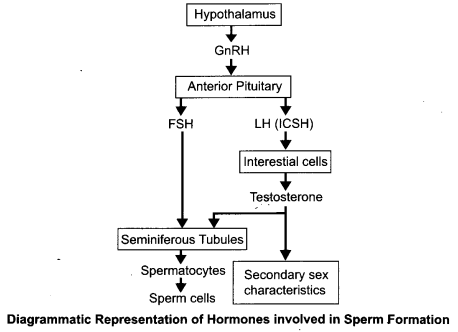
The hormones involved are:
- Gonadotropin Releasing Hormone (GnRH)
- Luteinising Hormone (LH)
- Follicle Stimulating Hormone (FSH
Answer 25.
The lac operon consists of one regulatory gene (the i gene) and three structural genes (z, y, and a).
The (i gene) codes for the repressor of the lac operon. The z gene codes for beta-galactosidase (β-gal), which is primarily responsible for the hydrolysis of the disaccharide, lactose into its monomeric units, galactose and glucose. The y gene codes for permease, which increases permeability of the cell to
β-galactosides. The a gene encodes a transacetylase. Hence, all the three gene products in lac operon are required for metabolism of lactose.
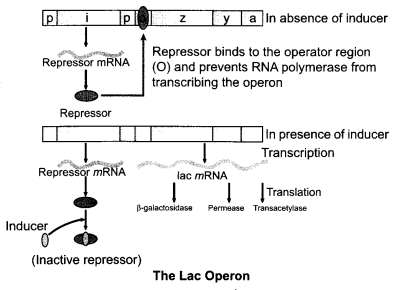
Lactose is the substrate for the enzyme beta-galactosidase and it regulates switching on and off of the operon. Hence, it is termed as inducer. In the absence of a preferred carbon source such as glucose, if lactose is provided in the growth medium of the bacteria, the lactose is transported into the cells through the action of permease. The lactose then induces the operon in the following manner. The repressor of the operon is synthesised (all-the-time – constitutively) from the i gene.
The repressor protein binds to the operator region of the operon and prevents RNA polymerase from transcribing the operon. In the presence of an inducer, such as lactose or allolactose, the repressor is inactivated by interaction with the inducer. This allows RNA polymerase access to the promoter and transcription proceeds. Essentially, regulation of lac operon can also be visualised as regulation of enzyme synthesis by its substrate. Glucose or galactose cannot act as inducers for lac operon. Thus, regulation of lac operon by repressor is referred to as negative regulation.
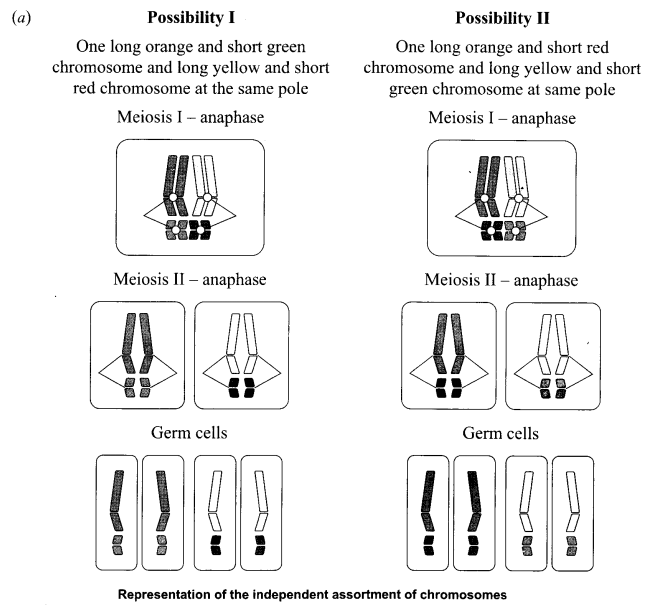
(b) The requisites for a molecule to be a genetic material are:
- It should be able to generate its replica (Replication).
- It should chemically and structurally be stable.
- It should provide the scope for slow changes (mutation) that are required for evolution.
- It should be able to express itself in the form of ‘Mendelian Characters’.
Answer 26.
The food or energy relationship is expressed in terms of number, biomass or energy. The base of each pyramid represent the producer or the first trophic level while the apex represents tertiary or top level consumer. The three ecological pyramids that are usually studied are:
(a) pyramid of number;
(b) pyramid of biomass and
(c) pyramid of energy
Calculations of any energy content, biomass, or numbers must include all organisms at that trophic level. No generalisations can be true with a few individuals at any trophic level into account. Also a given organism may occupy more than one trophic level simultaneously. One must remember that the trophic level represents a functional level, not a species as such. A given species may occupy more than one trophic level in the same ecosystem at the same time; for example, a sparrow is a primary consumer when it eats seeds, fruits, peas, and a secondary consumer when it eats insects and worms.
In most ecosystems, all the pyramids, of number, of energy and biomass are upright, i.e., producers are more in number and biomass than the herbivores, and herbivores are more in number and biomass than the carnivores. Also energy at a lower trophic level is always more than at a higher level. .
The pyramid of biomass in sea is also generally inverted because the biomass of fishes far exceeds that of phytoplankton. Pyramid of energy is always upright, can never be inverted, because when energy flows from a particular trophic level to the next trophic level, some energy is always lost as heat at each step. Each bar in the energy pyramid indicates the amount of energy present at each trophic level in a given time or annually per unit area. There are certain limitations of ecological pyramids such as it does not take into account the same species belonging to two or more trophic levels. It assumes a simple food chain, something that almost never exists in nature; it does not accommodate a food web. Moreover, saprophytes are not given any place in ecological pyramids even though they play a vital role in ecosystem.
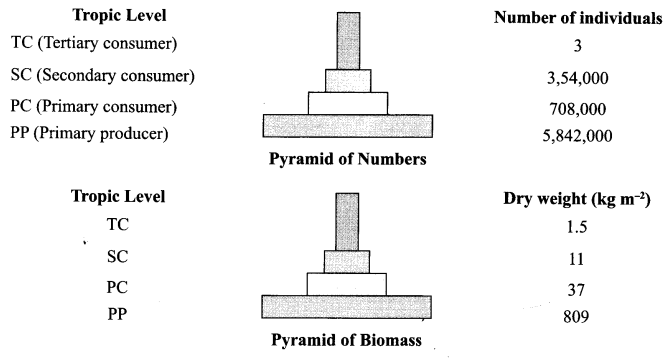
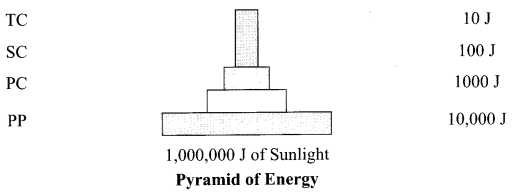
The movement of nutrient elements through the various components of an ecosystem is called nutrient cycling or biogeochemical cycles.
Nutrient cycles are of two types:
(a) gaseous and
(b) sedimentary.
Carbon cycling occurs through atmosphere, ocean and through living and dead organisms. A considerable amount of carbon returns to the atmosphere as CO2 through respiratory activities of the producers and consumers. Decomposers also contribute substantially to CO2 pool by their processing of waste materials and dead organic matter of land or oceans. Some amount of the fixed carbon is lost to sediments and removed from circulation. Burning of wood, forest fire and combustion of organic matter, fossil fuel, volcanic activity are additional sources for releasing CO2 in the atmosphere.
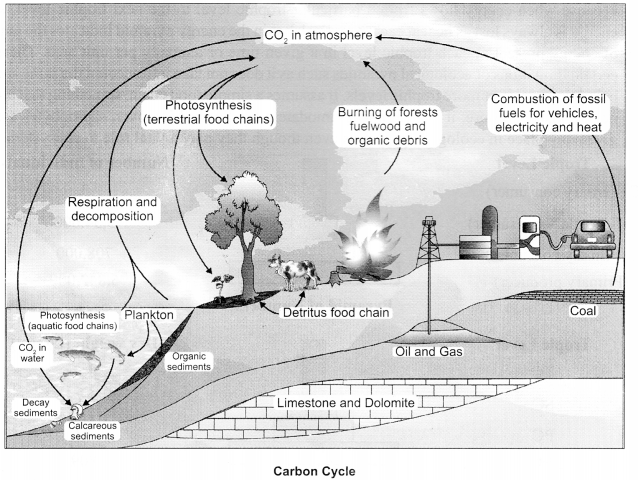
We hope the CBSE Sample Papers for Class 12 Biology Paper 3 help you. If you have any query regarding CBSE Sample Papers for Class 12 Biology Paper 3, drop a comment below and we will get back to you at the earliest.